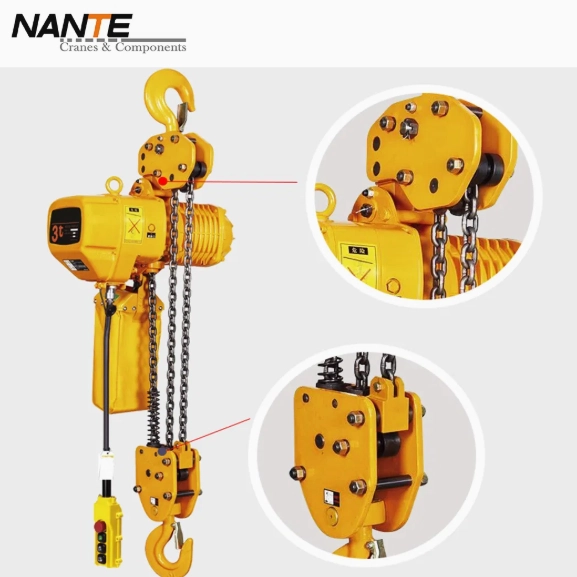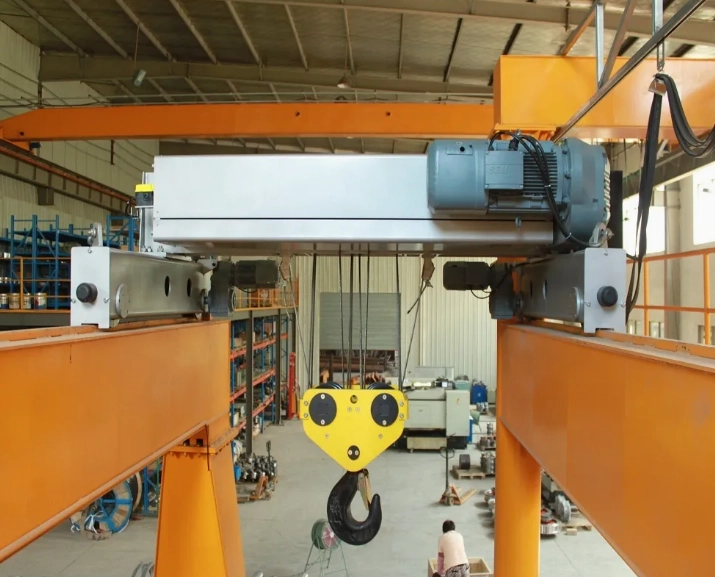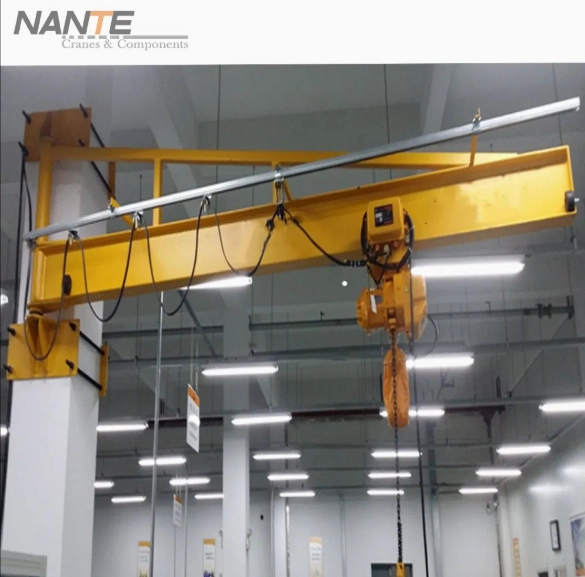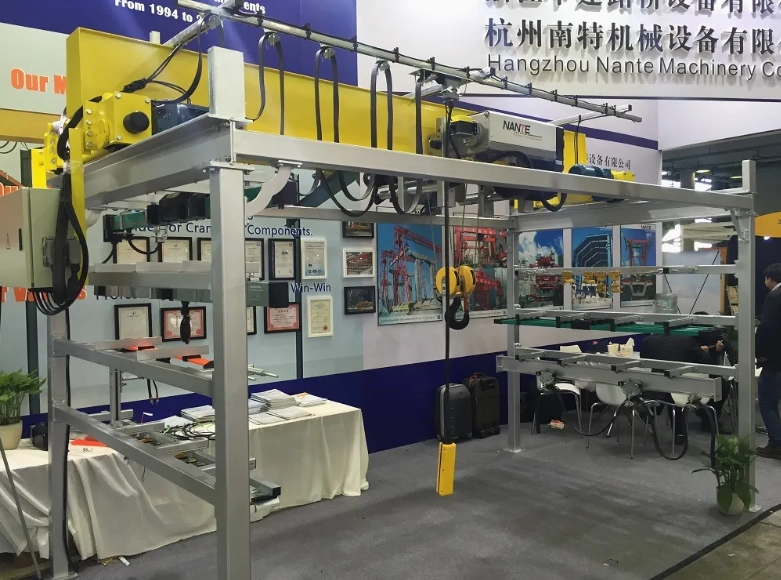Industrial Electric Chain Hoist for Fabrication Plants – Engineered for Maximum Uptime
Industrial Electric Chain Hoist for Fabrication Plants – Engineered for Maximum Uptime
Date: 2025-07-04 Share:
Introduction
Fabrication plants lift heavy items like steel plates and machines to keep work going. Industrial electric chain hoists handle these jobs well. They ensure little downtime and high output. These hoists are strong, accurate, and made for busy factories. This article looks at their features, benefits, uses, and care tips. It helps factory managers pick the right hoist. By knowing these hoists, you can improve work and safety.
What Are Industrial Electric Chain Hoists?
Industrial electric chain hoists are powered tools. They use a metal chain to lift and lower heavy loads. Unlike hand-powered hoists, they use electricity. This cuts down effort and speeds up work. They’re great for fabrication plants where lifting heavy stuff is common.
Key Components
- Load Chain: Made of tough steel, it lifts and lowers loads safely.
- Electric Motor: Runs the hoist for steady work.
- Gearbox: Passes motor power to the chain for smooth moves.
- Hook: Has a safety latch to hold loads tight.
- Control System: Uses a pendant or remote for easy, exact control.
- Frame: A strong steel or aluminum body holds all parts.
These hoists run on single-phase or three-phase power (110V–400V). They lift 0.5 to 20 tons. They often work with overhead cranes, jib cranes, or workstation setups for more options.
Applications in Fabrication Plants
Electric chain hoists are handy tools in fabrication plants. They help with many tasks:
Material Handling
They lift raw items like steel plates or beams for cutting or welding. This makes work faster and smoother.
Machinery Movement
Hoists move heavy machines or tools during setup or fixes. They save time and cut down on hand work.
Finished Product Transport
They carry finished parts, like frames or panels, to storage or shipping spots quickly.
Workstation Tasks
In assembly lines, hoists help with repeated lifting. For example, they align parts for welding. This keeps work accurate and workers safe.
These uses make electric chain hoists key for keeping plants efficient and safe.
Features Engineered for Maximum Uptime
Electric chain hoists are built to keep working with little downtime. They have features for tough jobs:
Robust Design and Materials
- Strong load chains, often with rust-proof coatings, last a long time.
- Tough steel or aluminum frames handle hard conditions.
- High IP ratings, like IP55, keep out dust and water.
Advanced Safety Features
- Overload protection stops lifting if the load is too heavy. This prevents damage.
- Limit switches stop the hoist at set points to avoid going too far.
- Fail-safe brakes hold loads if power fails.
- Emergency stop buttons let you halt the hoist fast for safety.
Precision and Control
- Adjustable speed control (8–28 feet per minute) places loads exactly.
- Pendant or remote controls make operation easy and less tiring.
Energy Efficiency
- Efficient motors use less power and stay cool.
- Regenerative brakes turn motion energy into power, saving electricity.
Low Maintenance Design
- Simple designs make repairs and checks easy.
- Easy lubrication cuts down care time.
- Rust-proof options reduce wear in tough settings.
Versatility
- Options like hook suspension, trolleys, or low-headroom designs fit different spaces.
- Various voltage options match different power systems.
These features keep hoists running well, cutting downtime and raising output.
Benefits in Fabrication Plants
Electric chain hoists bring many advantages to fabrication plants:
High Efficiency
Quick lifting speeds and automation save time. Workers can focus on other jobs. This boosts overall work output.
Safety
Strong safety features like overload protection and fail-safe brakes stop accidents. They keep workers and tools safe.
Compact Design
Their small size fits in busy workshops or assembly lines. They work well in tight spaces without losing power.
Cost-Effectiveness
Lower care and power costs compared to hydraulic or hand hoists save money over time.
Durability
Rust-proof materials make them last long, even in tough places like metal or chemical plants.
Precision
Adjustable speed control places loads accurately. This is key for tasks like aligning parts for welding or building complex items.
These advantages make electric chain hoists a wise choice for better factory work.
Maintenance Practices for Maximum Uptime
Regular care keeps hoists reliable and safe. Here are key steps:
Regular Inspections
- Daily: Look for damage, wear, or odd noises.
- Weekly: Check bolts, gears, and oil levels.
- Annual: Test with loads to meet safety rules.
Lubrication
- Use maker-approved oils on the chain, gears, and motor. This cuts friction and wear.
Cleaning
- Clear away dust, dirt, or metal bits to avoid buildup.
- Use rust-proof treatments in wet or chemical-heavy places.
Electrical Checks
- Check wires and connections for wear or rust.
- Look at the motor and controls for overheating or strange noises.
Load Testing
- Do static and dynamic tests to check performance and safety.
Operator Training
- Teach workers how to use hoists, respect load limits, and follow safety rules.
- Make sure they know how to use emergency stops and handle problems.
Record Keeping
- Write down checks, fixes, and oiling to track the hoist’s condition. This meets legal rules.
These steps keep hoists working well and avoid sudden stops.
Choosing the Right Electric Chain Hoist
Picking the right hoist means looking at your plant’s needs:
Load Capacity
Pick a hoist that handles your heaviest loads with extra safety (0.5–20 tons).
Duty Cycle
Choose a duty rating (H2–H4) based on how often you lift.
Environmental Conditions
Use rust-proof chains or coatings in dusty, wet, or chemical-heavy places.
Power Supply
Make sure the hoist matches your plant’s power (110V–400V, single or three-phase).
Space Constraints
Pick small or low-headroom models for tight spaces.
Safety Features
Choose hoists with overload protection, limit switches, and fail-safe brakes for top safety.
Industry Standards and Compliance
Electric chain hoists must follow rules to ensure safety and reliability:
- OSHA (US): Requires regular checks, load tests, and worker training.
- LOLER (UK): Needs six-month checks and care records.
- ASME B30 (US): Sets rules for hoist design, use, and care.
- CE Marking (EU): Shows the hoist meets European safety rules.
Following these rules keeps workplaces safe and avoids legal trouble.
Challenges and Considerations
Electric chain hoists are very useful, but there are challenges:
Initial Cost
They cost more at first than hand hoists. But their efficiency and strength make them worth it.
Maintenance Needs
Regular oiling and checks take time and skilled workers.
Environmental Sensitivity
Tough conditions may need extra protection, like stainless steel chains.
Operator Training
Good training is key to avoid misuse and accidents. This affects uptime.
Handling these challenges keeps hoists reliable and working well.
Why Choose Nante Crane
Nante Crane is a trusted maker of lifting tools. They offer CE-certified electric chain hoists for industrial use. Their products are tested to ensure quality and safety. With many hoist options and full support, like setup and care services, Nante Crane is a dependable partner for fabrication plants. Contact Nante Crane to see their solutions.
Common Questions
Q1: What is the typical lifespan of an electric chain hoist?
A1: With good care, they last 10–15 years.
Q2: How often should electric chain hoists be inspected?
A2: Do daily visual checks, weekly detailed checks, and annual load tests.
Q3: Can electric chain hoists be used outdoors?
A3: Yes, with proper IP ratings and rust-proof materials.
Q4: Are there energy-efficient electric chain hoists available?
A4: Yes, many have power-saving motors and regenerative brakes.
Conclusion
Industrial electric chain hoists are key for fabrication plants. They offer efficient, safe, and reliable lifting. Their strong design, safety features, and low care needs ensure maximum uptime. This boosts work output. By picking the right hoist based on load, environment, and safety needs, and following good care practices, factories can improve work. For top-quality hoists and expert help, visit Nante Crane to find the best solution for your plant.







